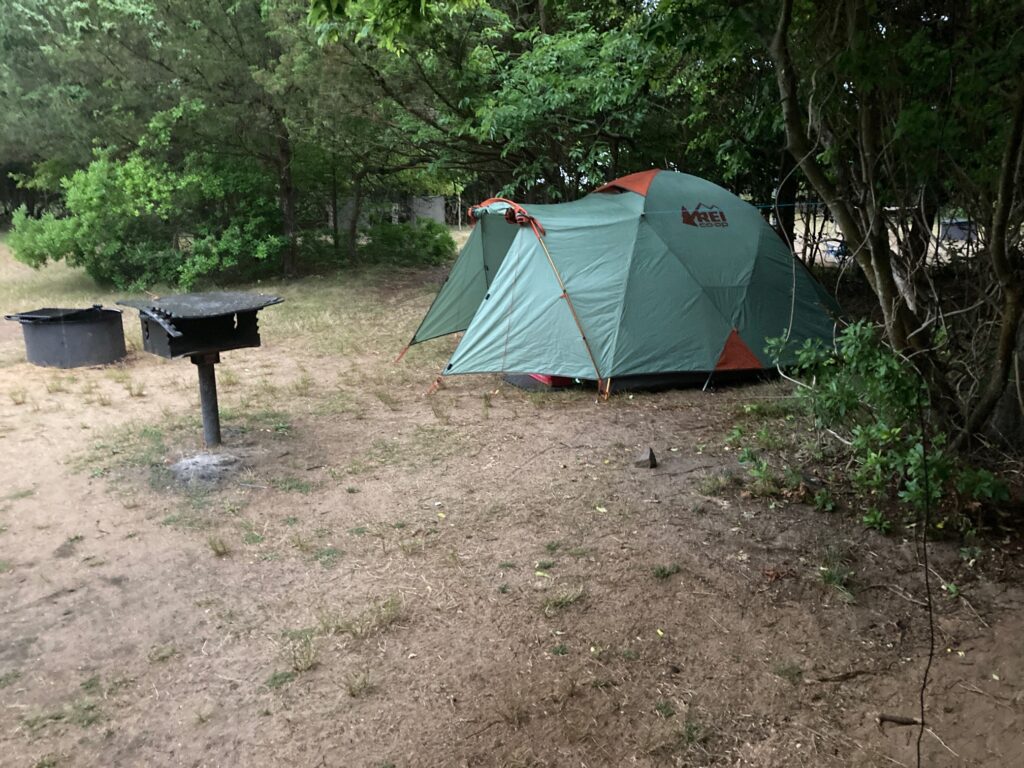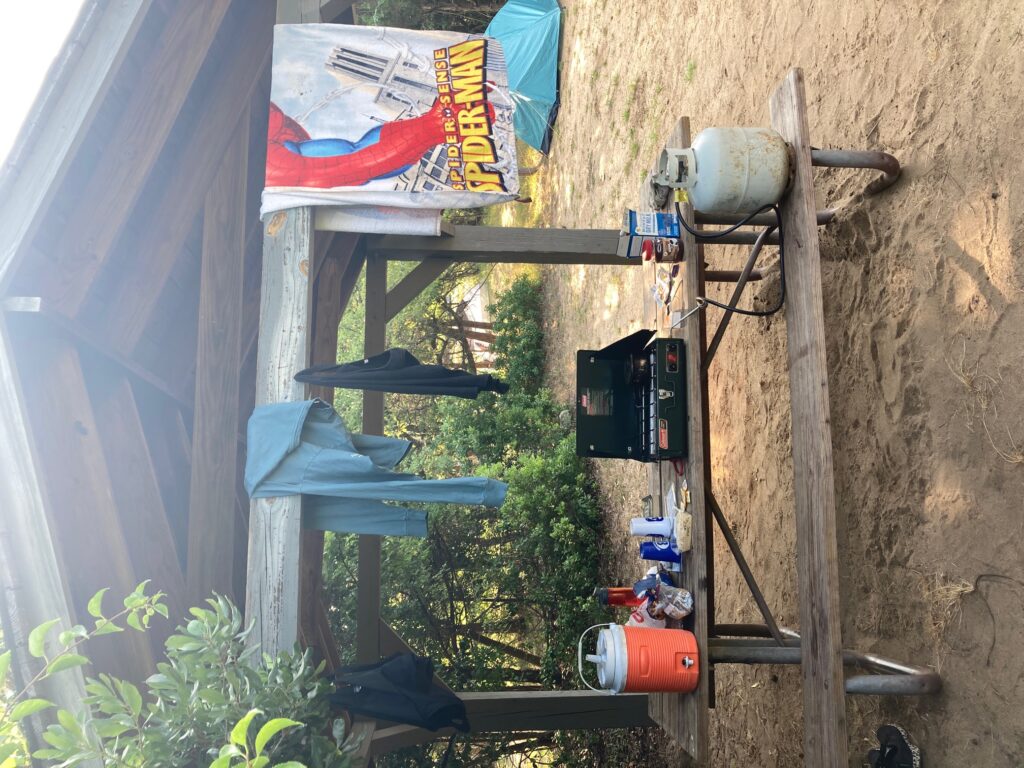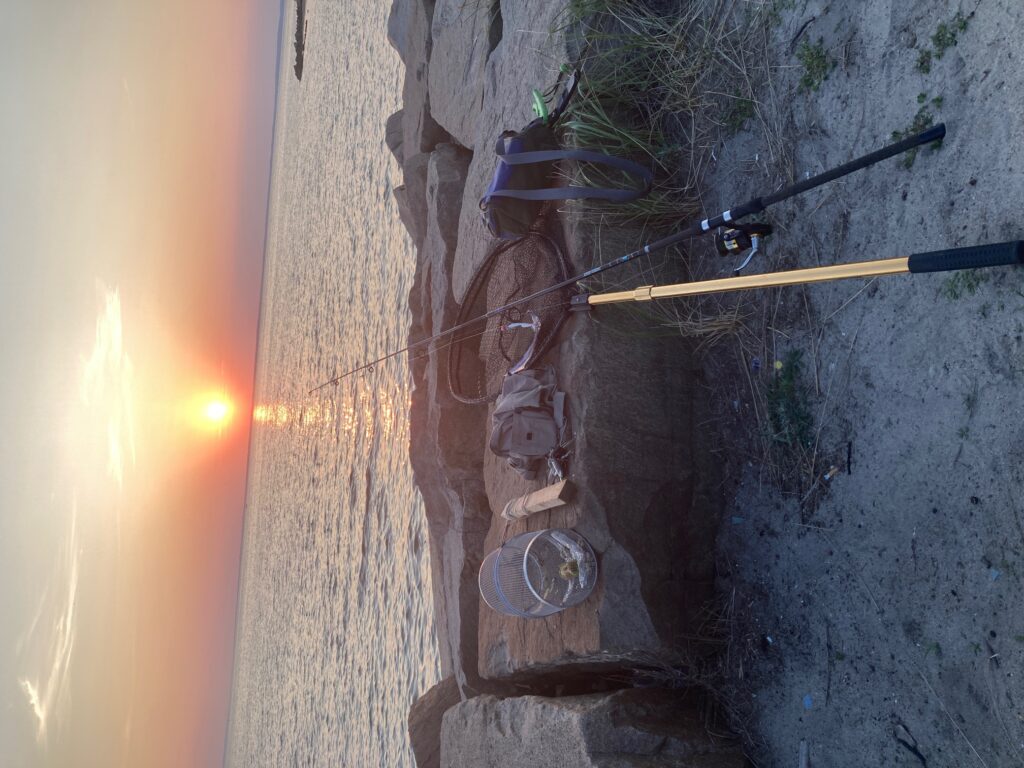Posts Tagged → camping
Midsummer report
My apologies for the long absence here. Summer is in full swing and our family has been operating at full tilt speed. Time only for doing things, and none for writing about it all, until now.
First off, our oldest kid was married on Independence Day. Held at a pretty and historic farm, it was a fantastic wedding, and we feel like we acquired a wonderful addition to our family. However, the preparation necessary for that event took up a lot of time and energy, for many months. And then there was the recovery week. And then there was the vacation week. Hence no blog posts. Full credit to my wife for all of the wedding planning.
At least I myself am back in the saddle, while other people around me are still recovering from their vacation. Not everyone does well with the surf fishing bum lifestyle, including sleeping on the beach, eating questionable food from a warm cooler that has been pawed over and drooled on by feral raccoons, and drinking fetid water. I myself thrive in this kind of environment, and so I am back to report back to our three readers.
What can I say about the wedding other than I fired our small black powder cannon seven times, for good luck. It was Independence Day, and while the venue does not allow fireworks, they did allow the cannon (it’s a cast iron, steel sleeved replica swivel gun with a 1.75″ bore). And in my speech as the bride’s father, how could I miss an opportunity to point out that Independence Day was brought to us by citizens with guns? That is a fact, is it not?
And (of course, I guess) I heard back afterwards that some of our wedding guests were offended by the cannon and also offended by my mention of the origins of American freedom – citizens with guns. You can’t make this stuff up if you tried, like it’s a Hollywood movie script caricature of spoiled rotten children who get everything that Planet Earth can provide and yet nonetheless complain about it. Something like “The food here is terrible and the portions are so small.”
Are Americans now really offended by Independence Day fireworks? Are they offended by displays of patriotism and mentioning of historical facts that unfortunately run contrary to some evil political narratives that privately owned guns are bad and our freedom was brought to Americans by a immaculately conceived federal government that descended from Heaven? Are some wedding guests now so crass that they actually complain about the bride’s father setting off his celebratory toy cannon for the enjoyment of all the normal fun-loving people in attendance?
I have a hard time believing these things, but I did get to witness this stuff. America is in big trouble when its own citizens, young and old, hate its founding and can’t give a proud father his one moment and some space to celebrate it. Jiminy crickets.
Just returned from a subsequent beach trip to a a long spit of federally managed property on the east coast. The National Park Service rangers were 99% normal, nice, intelligent Americans, thank you very much, Gage, Donald, and Stephen.
In this national park there is a problem with artificially high numbers of deer, foxes, and racoons. They have no natural predators and they are multiplying at breakneck rates and having huge negative impacts on the environment and local ecology. Vegetation shows a distinct deer browse line about four feet above the ground, and the racoons are everywhere, aggressive, and aiming to ruin your trip. I watched a red fox steal a camper’s breakfast sausage meal right off of his plate on the guy’s picnic table. We had raccoons patrolling our campsite and under our table as soon as we broke out our food. They will grab your food right out of your hand. It is a fact that raccoons are host to some nasty parasites they excrete in their poop, which was abundantly displayed all around the campsites. Raccoons are also the number one vector for rabies among wildlife.
Aside from posing health threats and incessantly badgering the humans who are trying to enjoy the park, the foxes and raccoons also eat the eggs of rare nesting shore birds. These rare birds enjoy huge swaths of cordoned off human-free dunes and beaches in the park (and also on federal and state lands out on Long Island, like Orient Point and Montauk). And yet the same exact NPS staff enforcing the human no-go dune zones policy are absolutely fine with the overabundant nest-raiding foxes and raccoons that render all the no-go zones meaningless. The staff do not support hunting or trapping these destructive pests, either to improve the park visitor experience or to protect the natural environment.
How can the rare birds successfully nest on the ground and hatch their chicks there when the artificially super overabundant egg-eating raccoons and foxes are allowed to roam at will?
Talking with various National Park Service staff about this problem resulted in exposure to various levels of education and serious/unserious mindset. Most of the NPS staff acknowledged there is a wildlife problem on site that must be addressed. Hunting the deer and trapping the foxes and raccoons is the normal and responsible way to deal with this artificial human-caused environmental problem. These are the responsible and serious ways of addressing a visitor problem on land that is owned by the US taxpayer and whose management is entrusted to taxpayer-paid bureaucrats.
However, when I mentioned the above normal solutions to a young, handsome, tall NPS Park Policeman patrolling our campground, he responded “The same can be said about humans — there are just too many humans. And your solution to the overabundant raccoon problem is not humane.” He would get rid of the humans and allow the artificially high numbers of nuisance wildlife to proliferate. With taxpayer-paid federal employees of this guy’s low caliber and high wokeness quotient, the park visitor experience is going to degrade. C’mon, NPS, you can screen your employee applicants better than this. This foolish people-hating young guy should never have a gun and a badge, much less wear an NPS uniform.
Overall the surf fishing was fun if mostly unproductive. Probably due to the high heat and ferocious sunshine. I can report that catching cownose/ bullnose rays on strong surf tackle is a hoot, but then safely decoupling that animal from the tackle is a whole other thing. They whip their barbed tails around trying to nail the fisherman, who is trying to release them back into the ocean (I learned to place something heavy on the tail while using heavy pliers to remove or break off the hook). We did witness a large shark violently feeding close to shore, and it would be a fair guess to say it was probably eating these rays, which we caught and saw in abundance on both the bay side and the ocean surf side.
So that is the mid-summer report. Fast action, lots of family, some big family celebration and lots of family movement across the beautiful American landscape for work and vacation. I hope that you the reader are also enjoying your summertime. Summer is such a glorious time to be with family and friends, to visit new places, to camp out under the stars and cook over an open fire, to think through life’s normal challenges and to spend time with people we love…and then it is over just when we are all starting to really get into it.
So make the most of your summer.
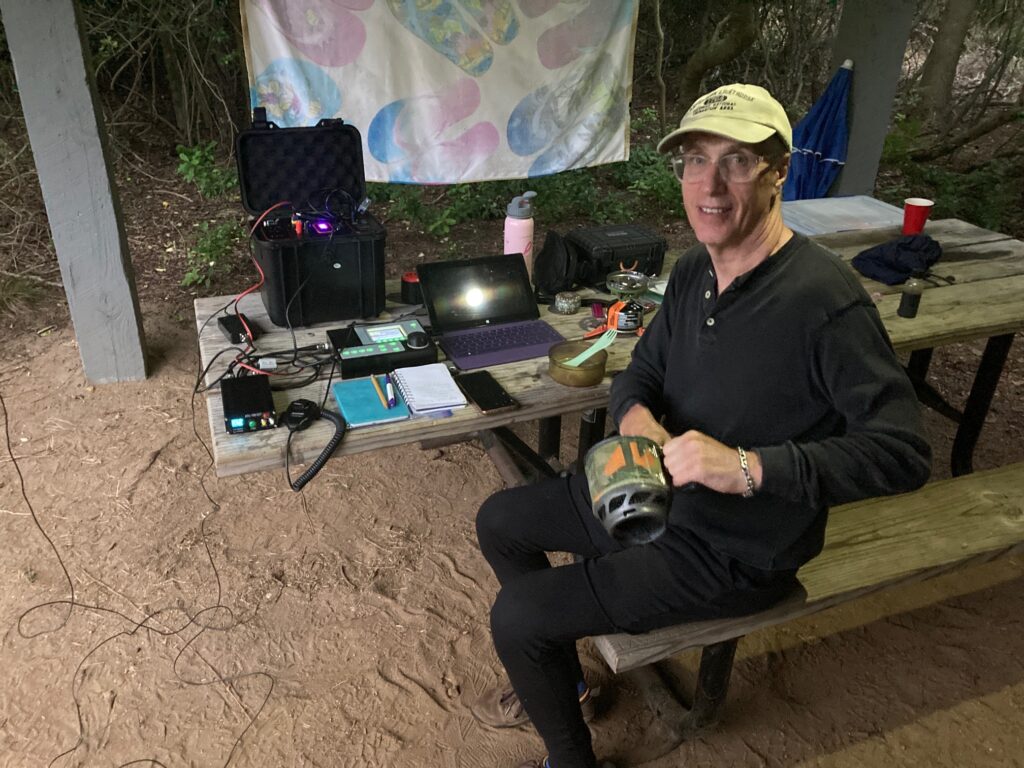
Campsite neighbor Steve, a PhD engineer ex-patriot Brit and defiant leftist, helped MAGA Maniac Josh fix my malfunctioning headlamp, demonstrating that it’s easy to be enemies when separated by keyboards and easy to be friends when living side by side
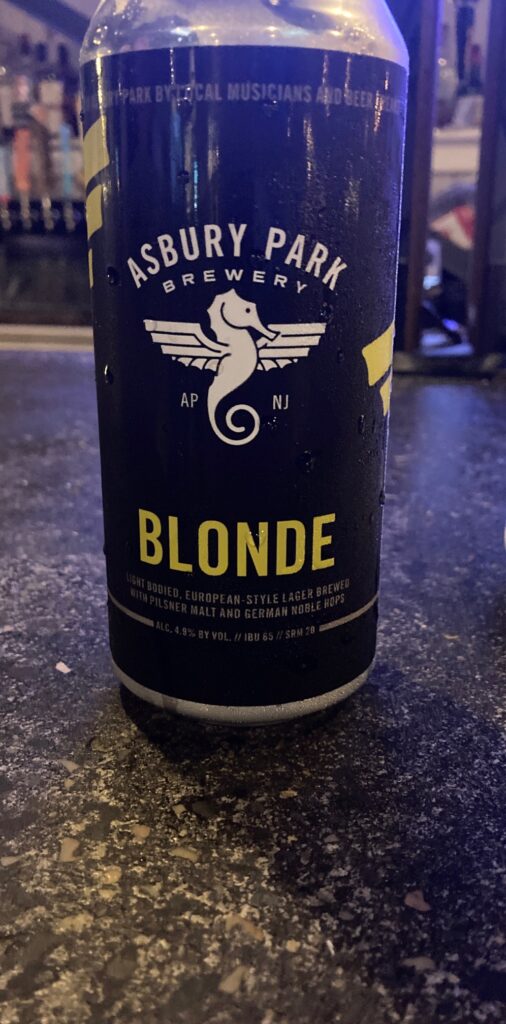
Asbury Park Brewery is a local flavor that I was happy to support. No sign anywhere of Bud Lite or Budweiser anything, thankfully

Symbol of foolish National Park Service policies seeking to protect rare shore birds by excluding people from their habitat, but allowing artificially overabundant populations of nest-raiding raccoons and foxes to roam at will.
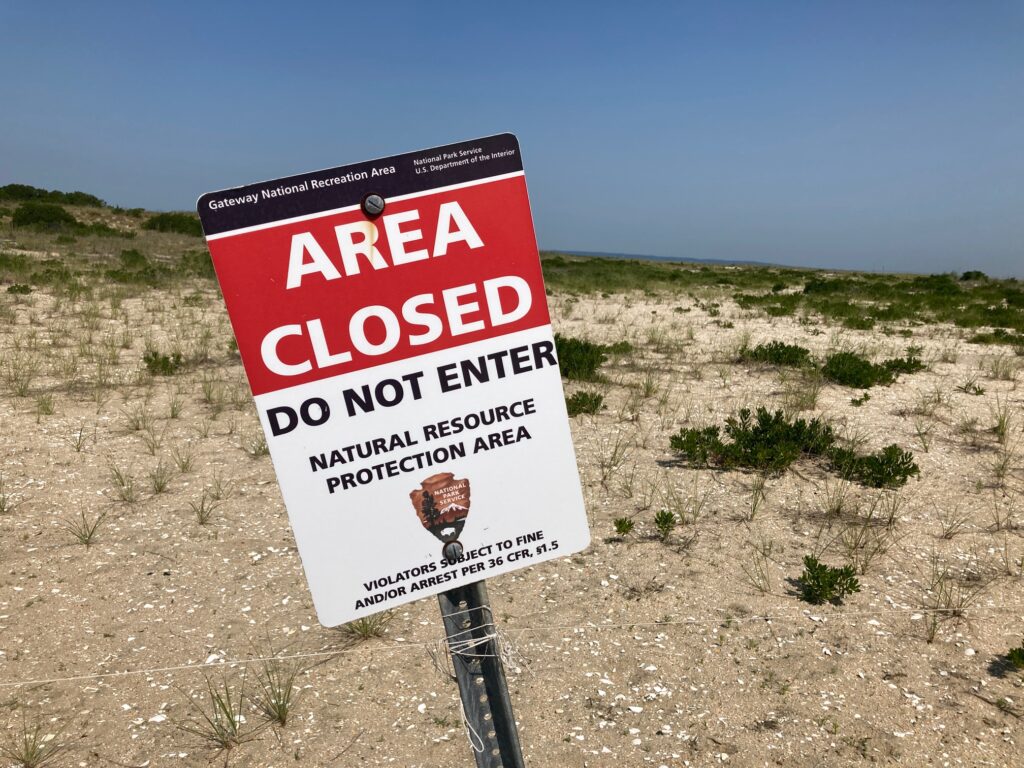
Beach goers nonetheless entered this area because there were zero nesting birds in it and there were literally tons of foxes running around in it. Come on National Park Service, you can do much smarter than this
Irv’s summertime camping gear recommendations
Summertime Camping Equipment Review
The good, the bad, and the ugly….maybe
by
Irving Krasnoshtayn, Special Guest at joshfirst.com
When I was a kid, my family did not go camping. There was nowhere to go. The “open space” in Brooklyn, New York, was the little crack between the concrete slabs on every sidewalk where small sprouts of grass grow. Football, hockey, even baseball games were played in the street or in a crowded public park if one was near enough. People in tents were known as homeless. The first time I went camping was with a bunch of college friends over 20 years ago. It was a poorly planned and ragtag experiment, by guys with more spirit than knowledge. We brought an axe and chopped our own firewood, and then thought we were real outdoorsmen. More than anything we all got giant blisters on our soft city hands. Lots of things have changed since then, but my enjoyment of camping only grew from that one fun misadventure.
Fast forward just a few years and now I am the dad with little kids who excitedly ask me about camping over summer vacation. But unlike my childhood, society today is a lot more mobile, and outdoor recreation is a lot more widespread, common, and much more easily accessible. When you have a couple kids and a wife, you have to think not only about the easy, happy family coziness, fresh air, and the sunshine aspects of camping, but also about everyone being comfortable, repelling bugs, people going potty in the middle of the night, and having decent food. Meeting all of those goals with a family means that we get to try out a lot of camping gear, albeit mostly car camping and not always wilderness treks. Our destinations are usually commercial campgrounds and state and county parks. So here’s my honest review of some things I rely on when family camping. I know there are plenty of dads and moms out there who are hungry for this kind of information. Links to many of these items are below.
Tents: I have two tents, each costing around $100. One a six-person and the other an eight-person, both made by Coleman. But those sizes are a lie because each tent fits two people fewer than advertised, especially with all their gear. You have to think about keeping your stuff dry inside the tent in bad weather, so a backpack takes up the space of a person.
These Coleman tents are relatively easy to set up and they have been reliable. But buy a bigger tent than you think you need, unless you will be backpacking it on a mountain. In which case you will want the absolute lightest gear, which is a whole other story. Use strong steel stakes, they don’t bend as easily as aluminum and last longer. I also put down a cheap tarp on the ground slightly larger than the tent, to take off shoes before we get into the tent and to protect the bottom and keep it from tearing.
Sleeping bags: I have owned more sleeping bags than I can count on both hands. This key part of camping has been a long process for me, and I hope you can learn from my mistakes. In the course of learning sleeping lessons while camping the hard way, I have discovered I really don’t like mummy bags. Mummy bags are sold as a common camping cure-all, but they best fit small framed and narrowly proportioned people, while I want room for my tree trunk legs and wide shoulders. Don’t buy a bag from an unheard of company, like I have, while trying to save money; you will end up paying the real price in comfort and enjoyment, which is worth more than money. At the lower end of the price range, say around $40, Coleman makes decent sleeping bags. Some have cotton lining, some nylon, some acrylic, some flannel, but either way make sure you like the particular material against your skin before you walk out of the store with the bag. I have used everything from 20 degree bags to 50 degree bags, and absolutely none are as warm or breathable as they claim. Until you test your bag and understand its real limits, make sure you bring extra base clothing to keep warm at night. A drinking bottle filed with hot water can help overnight. Coleman’s Brazos is a decent model. A stuff sack for storing the sleeping bag short term is great to have too. To preserve their fill loft, sleeping bags must be stored long term either hung up hanging freely, or in large sacks that do not compress them.
Sleeping pads: One of the most important things I have bought for camping is a sleeping pad. I like a comfy sleep, what can I say. Once you sleep somewhere rocky you will understand why a good sleeping pad is important. Besides, I’m getting old and want to be comfortable. Walmart sells a cheap roll up pad like the military uses that is about a half an inch thick, and that is the minimum I would recommend. I highly recommend the best pad you can afford, either closed cell foam or inflatable. I have one for each family member of different types and thicknesses. The egg crate type is not bad but I prefer a firm type made of open/closed cell foam.
I own a few self-inflating pads but I’m afraid they might develop a hole and deflate like happened to me once. I like reliability, which the closed cell foam has.
Pillow: When camping with our car, we bring our pillows from home. When backpacking I take one of two inflatable pillows, but some people just bring a pillow case and stuff it with their clothing. That works.
Fire: Although I own many axes, such as the decent Cold Steel axe, I now rarely use one while camping. Instead I use a few different saws to get my firewood. Silky saws of Japan makes the best saws money can buy. The Silky Gomboy with medium teeth is the most comfortable and fastest cutting saw I know of besides using a chainsaw. Their teeth are wider than the spine so they cut very well and don’t bind. They are a pleasure to use but have been known to snap if used forcefully. Take your time and let the saw do the work. They can be found on sale for around $40 and like all good kit, are well worth it. Get the largest one you can afford. “Project Farm” of youtube fame recommended another couple of saws. I will be “real world” testing them soon.
Fire Starting: This is something I have practiced extensively and have found campers need to carry more than one way to start a fire, and know how to use each one. Yes, Bic lighters are a go-to but when it is freezing, snowing, or raining they may not work. Always carry your Bic/gas lighters on your person in a pocket, and NOT in your pack. The reason is your body will keep the lighter warm and the contents in a fluid and flammable state. If the lighter is really cold, the butane will not turn into a gas when you try to light it and it won’t work. Zippo lighters are okay as long as they don’t get wet or leak.
Wind is another reason I don’t rely on gas lighters or survival matches. If you do buy survival matches, make sure the container is waterproof and they are the type that can stay lit underwater. Yes they make those. I used a waterproof pill container filled with LIFEBOAT matches and cotton balls for my kids.
I have made videos throwing every type of lighter or match into a half foot of snow or a bucket of water, and the only thing that was reliable was a Ferrocerium rod. Known as a Ferro rod, I now buy them in bulk and make handles for them out of spent rifle cases. Use the spine of your knife and you will make all the sparks you need to start a fire.
At home I prepare a few cotton balls dipped into Vaseline, and store them in a small Ziploc bag. They have the added benefit of protecting your skin/hands. A Ferro rod will light one immediately and the Vaseline in it will burn for a good minute or two, if not longer. I will sometimes make feather sticks which a Ferro rod will also easily light if done correctly. I own magnesium fire starters, and they work, but they aren’t necessary. Again if it’s windy, the magnesium will often get blown away. Some people like to use military trioxane, but this extra expense is not necessary.
Camp chair: Bring a chair for each person if you can. This is advice that is easy when car camping and very difficult while backpacking. I have not yet found a lightweight folding chair that I like.
Cooking: I have spent hundreds of dollars on a titanium stove and the latest everything else for cooking, and have concluded just a few items are all I need to cook good food while camping. Stanley makes a $30-$40 frying pan kit which is worth it. Titanium frying pans which I own are lightweight but develop hotspots that then cook unevenly. The Stanley frying pan kit cooks everything evenly and comes with two plates, and a take-apart spatula that is almost priceless. Stanley also makes a few other kits including a pot kit and a mug/cup kit which are also very good. I have used them all extensively, and they develop a blackened bottom with open fires. Someone scientifically tested blackened pots and it will boil water approximately a minute faster because it absorbs the heat better. I have a lightweight folding stainless steel grate for chicken, hot dogs and burgers. Works great. I like a titanium cup for quickly boiling water for making tea or a ramen type meal. Lightweight Titanium spoons and forks are also worth buying. Better than any plastic.
Stoves: I like and own many packable wood stoves. The Solo stove is GOOD. It burns wood very efficiently and fast. Sometimes too fast, so you will need a lot of twigs on hand because it doesn’t hold much and you have to keep adding to keep the fire going. Esbit stoves don’t heat up enough for my liking and alcohol stoves might work, but I don’t want to carry alcohol that I can’t drink. Firebox makes quite possibly the best balance of reliability, compactness, yet high capacity wood burning stove on the market. It is amazing and I highly recommend it. The Firebox Nano model is tiny yet unfolds large enough to cook a morning meal without any fuss.
Cooler: I prefer hard sided coolers, because they keep their shape and hold ice overnight, even in the hottest summers. They also repel the sharp claws of raccoons.
Lighting: You will need to see when it gets dark. I prefer headlamps over flashlights because they keep both hands free. I bring one for each person, even the kids. I give out glow sticks just to see where other people are. Any headlamp over 200 lumens is good. Wide beams are more useful for close range. In my work as an electrician, I use headlamps every single day. The cheaper brands have always failed me because they use cheap circuitry and switches that eventually fail just when you need them most. Energizer makes many excellent headlamps.
Eveready makes a good model for $10. On the higher end, Petzl, Streamlight, Black Diamond, Fenix, Surefire and many others make very good lights. Don’t buy a crappy light, because you don’t need to. The good ones don’t cost much more than the really bad ones. I don’t use rechargeable batteries when camping, because unless you have solar panels how are you going to charge it? I’m not going to carry a battery power bank. I bring an extra set of fresh batteries. [Editor’s note: I have used two different Anker solar chargers on long distance ten-day backpacking trips and they work well when matched with the right battery – JF]
Rope: Buy some paracord and keep it in different places where you might need ten or twenty feet of it. Home Depot sells a decent paracord. The brighter colors are better, because your eye will see them and stop your feet before you trip over them when they are guyed out around a tent or a tarp shelter. Also useful for tying down your stuff in strong wind.
Duct Tape: I like gorilla tape. It sticks better than any duct tape I have ever used. Wrap a few feet around something like your lighter.
Multitool: I prefer Leatherman. The wingman model has scissors, a pocket clip, and is relatively light.
And finally, knives: Few outdoor items are more iconic or representative of camping than a fixed blade knife or one of the newfangled, robust, easy-open folding knives. Everyone has different sized hands and skin, so everyone prefers a different handle material and shape, and thicker or thinner, longer or shorter. There are so many knives on the market, I should begin by telling everyone to always carry a pocketknife. Preferably one with a locking mechanism so it doesn’t accidentally close on your fingers. Swiss army knives are OK for home use, but I don’t prefer them as a daily pocket carry.
Fixed blades are also necessary. I’ll start by recommending the least expensive of the bunch, Mora knives of Sweden. They are the best bang for your dollar at the moment. I recommend stainless steel over carbon steel so that your knife won’t rust, and if there is one thing you are guaranteed of on a camping trip, it is that your knife will get wet and it won’t get put away dry.
At around $20, the Mora companion model is a great knife for many reasons. It has a comfortable handle and an excellent sheath which clips onto your belt without you having to take it off. Mora uses a Scandinavian grind on their knives, which is excellent for “Bushcraft” type work, which is a variety of light to heavy utility work, plus food preparation. I prefer full flat grinds which are much more versatile, particularly for food preparation.
ESEE knives have an unconditional lifetime guarantee. They come in 1095 high carbon steel which may rust if not cared for. (Use vaseline from the cotton balls or plain mineral oil to prevent rust)
I used the ESEE 4HM model (~$120) for an entire camping trip and found it excelled at everything. GREAT knife.
In the Outdoors, the sheath is just as important as the knife.
First Aid Kit: Always carry some type of first aid kit and know how to use it. I was an EMT, and based on my experience I think everyone should at least learn the basics. Know how to stop bleeding with pressure or how to stabilize/support a sprained ankle. Accidents happen, be prepared, and having a good first aid kit is step one in being prepared. Car camping first aid kits can be almost like a mobile field hospital in size, and backpacking first aid kits must be streamlined and geared towards treating foot blisters, burns, and knife cuts.
I put together my own first aid kit in a one- gallon waterproof Ziploc bag, including everything from Band-Aids to gloves and gauze to common medications like ibuprofen and aspirin.
Have a great summer camping with your family!
LINKS:
tents:
sleeping bags:
| Coleman Green Valley 30°F Cool-Weather … |
sleeping pads:
Foam Sleep Pad- Extra Thick Camping Mat for Cots, Tents, Sleeping Bags & Sleepovers
Saws:
Silky GomBoy Professional Folding Saw 240mm Medium Teeth (121-24)
| Silky GomBoy Professional Folding Saw 2… |
Samurai KISI FC-240-LH / 9 1/2″ (24cm) Folding Curved Blade Saw Made in Japan
| Samurai KISI FC-240-LH / 9 1/2″ (24cm) … |
Fire making:
Cooking: pots pans
Stoves:
| Lite Camp Stove | Solo Stove |
|
Headlamps:
Knives:
ESEE 4HM Fixed Blade Knife w/ Kydex Sheath & Micarta Handle
| ESEE 4HM Fixed Blade Knife w/ Kydex She… |
Kudos to Filson clothing
Filson is a clothing manufacturer in Seattle, making pretty much the most basic American clothing styles for the past 130 years.
Little has changed in their styles or fabrics. Boring? Maybe.
Flannel and wool shirts, wool and canvas coats and pants, wool long underwear, leather boots with wool insulation, tote and carry bags and purses, every item is made in America of virgin wool or different weights of canvas.
One short phrase describes Filson products: Brutally tough.
Or, “Last a lifetime.”
In an era of cheap Chinese crap and Asian sweatshop “designer” clothes, Filson stands alone, or probably alone. I am a consumer of top-quality outdoor clothing, and I cannot think of another manufacturer who makes anything like Filson’s clothing line.
Oh, sure, there are plastic and Gore Tex outdoor clothes galore. Eddie Bauer, LL Bean, Mountain Hard Wear, and others make some pretty good ones, which our family wears. Fleece coats, mountaineering parkas, super-sophisticated PhD plastic fiber clothes for the outdoor lifestyle. Some are married to goose down, which is genuinely warm.
But all of these synthetics catch on fire and turn the wearer into a large, running, screaming torch when exposed to flame. Or at the least they wilt, melt, smell very bad, and cease being useful when exposed to a camp fire hot enough to dry your damp undies and wet socks. In other words, the newfangled modern synthetics may weigh next to nothing and stop wind faster than a speeding bullet and locomotive, but they lack certain basic physical properties necessary to truly enjoy or survive the outdoors.
Wool and waxed heavy cotton canvas are nearly fireproof and can withstand tremendous force before tearing. Wool keeps the wearer warm even when wet. Yes, it is heavy compared to synthetics, but it is a lot quieter, actually it is silent, whereas even the best of synthetic fleece hunting clothes will leave a telltale “zip” sound when dragged across a sharp branch.
Filson forms a big part of my winter clothing selection. Mackinaw vests and coats of different colors and patterns form the core of the selection, and the double mackinaw coat in “Pennsylvania Tuxedo” red-and-black buffalo check plaid has kept me toasty warm in sub-zero temperatures day after day. This past week I wore the double mackinaw coat while flintlock hunting, and I never got cold. It was sub-zero every day.
Other wool clothes I wear are heavy camouflage Columbia hunting pants, Bass Pro Redhead heavy wool socks, Danner wool socks, knee-high SmartWool ski and hunting socks, and SmartWool long underwear. Yes, once in a while I break out the Eddie Bauer and Woolrich Adirondock plaid pants, jackets, and so on. They are real testaments to a world long gone, which dinosaurs like me cling to in misty eyed memories.
David Petzal is the gun writer for Field and Stream Magazine, and among many other witticisms and pithy one-liners, years ago he noted that all synthetic long underwear makes you smell like someone slaughtered a cow after a day, but wool long underwear can be worn for days without you or them being cleaned, and yet you don’t smell…too badly.
That’s the thing. Wool is natural. Like leather and fur, it is natural and fits the human body perfectly. We can sweat into wool for days on a hunt, and it just doesn’t smell bad. Oh, it may not smell fresh, but compared to the polypropylene synthetics, it does.
My Filson Mackinaw coat accompanies me on all my Adirondack wilderness hunts, serving as a blanket at night when the temperature inside the tent dips to 18 degrees. And yet after many years of being worn through thorn patches and rugged mountain brush, it shows zero signs of wear. That says it all.
Other favorites include the now discontinued styles of Tin Cloth logging jacket and Double Tin field coat, both of which I wear when hunting for small game in January and February, when thorns are a big part of the day. Some of these discontinued tin cloth coats have become collector’s items. Each one will last you your entire lifetime, and if you wax it at the end of the season, it will serve your kids, too.
So, kudos to Filson for making Best-quality, “old fashioned” clothing for a tech-happy generation. www.filson.com
Fifty years of designated wilderness
Two weeks ago marked the fiftieth anniversary of the signing of the Wilderness Act.
It applies to federal designation of remote areas, not to states. States can create their own wild areas, and some do. States closest to human populations and land development seem to also be most assertive about setting aside large areas for people and animals to enjoy.
I enjoy wilderness a lot. Hunting, camping, hiking, fishing, and exploring are all activities I do in designated wilderness.
Every year I hunt Upstate New York’s Adirondack Mountains, in a large designated wilderness area. Pitching a tent miles in from the trail head, the only person I see is a hunting partner. Serenity like that is tough to find unless you already live in northern Vermont, Maine, Montana, Idaho, Wyoming or Alaska. It’s a valuable thing, that tranquility.
This summer my young son sat in my lap late at night, watching shooting stars against an already unbelievably starry sky. Loons cried out all around us. A gentle breeze rustled the leaves on the birch trees above us and caused the lake to lap against our rocky shore.
Only by driving a long way north, and then canoeing on a designated wilderness lake, and camping on a designated wilderness island in that lake, were we able to find such peace and quiet. No one else was anywhere around us. We were totally alone, with our camp fires, firewood chores, fishing rods, and deep sleeps in the cold tent.
These are memories likely to make my son smile even as he ages and grapples with responsibilities and challenges of adulthood. We couldn’t do it without wilderness.
Wilderness is a touchstone for a frontier nation like America. Wilderness equals freedom of movement, freedom of action. The same sort of freedoms that instigated insurrection against the British monarchy. American frontiersmen became accustomed to individual liberty unlike anything seen in Western Civilization. They enshrined those liberties in our Constitution.
Sure, there are some frustrations associated with managing wilderness.
Out West, wilderness designation has become a politicized fight over access to valuable minerals under the ground. Access usually involves roads, and roads are the antithesis of a wild experience.
Given the large amount of publicly owned land in the West, I cannot help but wonder if there isn’t some bartering that could go on to resolve these fights. Take multiple use public land and designate it as wilderness, so other areas can responsibly yield their valuable minerals. Plenty of present day public land was once heavily logged, farmed, ranched, and mined, but those scars are long gone.
You can hike all day in a Gold Mine Creek basin and find one tiny miner’s shack from 1902. All other signs have washed away, been covered up by new layers of soil, etc. So there is precedent for taking once-used land and letting it heal to the point where we visitors would swear it is pristine.
Out East, where we have large hardwood forests, occasionally, huge valuable timber falls over in wilderness areas, and the financially hard-pressed locals could surely use the income from retrieving, milling, and selling lumber from those trees. But wilderness rules usually require such behemoths to stay where they lay, symbols of an old forest rarely seen anywhere today. They can be seen as profligate waste, I understand that. I also understand that some now-rare salamanders might only make their homes under these rotting giant logs, and nowhere else.
Seeing the yellow-on-black body of the salamander makes me think of the starry night sky filled with shooting stars. A rare thing of beauty in a world full of bustle, noise, voices, and concrete. For me, I’ll take the salamander.
The tonic of wilderness
Reading just about any wilderness outdoors report by hikers or wilderness advocates, you’ll have a tough time not meeting up with the well-worn phrase “the tonic of wilderness.”
All my life I’ve been a wilderness hound, and I don’t know what that phrase means. Whether day hiking, fishing, or camping with a rifle next to me many miles from the nearest road, my feelings about wilderness have zero association with the word tonic.
Euphoria, and drug-induced narcotic stupor are more accurate for my take-aways. That Cloud Nine feeling can stay with me for weeks after returning to human settlement. Getting older only makes it better, because so many layers are filtering the experience now. Water, stands of old conifers, some far off hill that sees one or two people a year, or a decade, these now are the templates upon which each new excursion is planned. Studying a topographic map now yields concrete images of what to expect in my mind, accurate or not.
Since last year I’ve taken to marching about with a heavy pack loaded with 50-65 pounds of steel as a means of getting back into some sort of decent condition. Sometimes I am fortunate enough to hike a local park for 30-60 minutes. Usually, it’s just my neighborhood that I’m tromping through in my rugged hunting boots. Concrete isn’t pretty to see, and my mind once again helps out. As the minutes tick by, a quiet euphoria overtakes the senses, and my eyes see trees, distant horizons, and unbroken scenery. My hand instinctively grips an imaginary rifle, and oblivious to cars whipping past, I wander unnamed marshes somewhere else.
If someone wants to call this the tonic of wilderness, OK. It makes no sense. But if that’s now the by-word, I’ll accept it. Just so long as I can get more, soon
